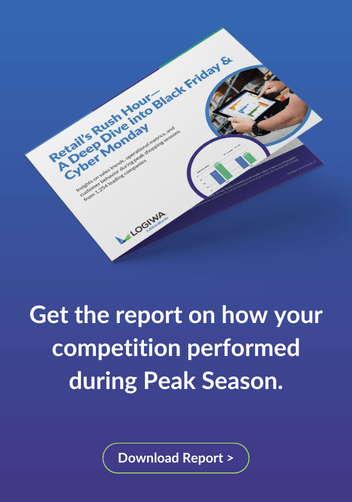The next step is actually shipping the product to the client. Staff picks and packs the order with the help of a Warehouse Management System (WMS). Then it passes to a shipping carrier, who transfers the order from the warehouse directly to the buyer. The carrier uses its own system to monitor delivery.
The entire order has passed through four different systems (or more!) before the customer receives their purchase. And if those systems don’t integrate with one another, deliveries can be delayed—or even lost.
Fortunately, Logiwa IO offers a solution. Our cloud-based WMS integrates with major ERPs, OMSs, and shipping carrier platforms. That makes it easier to manage order fulfillment and transfer data between systems.
WMS integration with ecommerce platforms
A warehouse may serve dozens of clients, from local retailers to online stores. Each customer requires inventory management, receiving new goods, and packing orders for customers. By choosing a WMS with integration capabilities, it’s possible to enhance all those functions. Here’s how.
Real-time order synchronization
One of the biggest benefits of Logiwa IO is its integration with major ecommerce platforms like Shopify, BigCommerce, and Amazon. Many online sellers rely on those platforms (or others we integrate with) to capture a client’s sale.
Since Logiwa IO connects directly to most ecommerce platforms, customer orders transfer automatically to the warehouse. There’s no need for any manual data entry or messaging between the warehouse team and retailers. That saves time and reduces errors.
Inventory management
Fluctuations in inventory can lead to stockouts and replenishment delays. If a warehouse relies on manual cycle checks for inventory management, there’s a real risk of errors. Mistakes make it harder for retailers to stay on top of current inventory levels and fill customer orders.
Logiwa IO offers real-time inventory tracking. Warehouse managers can easily identify when a product’s low on stock. Retailers have access to the same information, so they can quickly order replenishments and prevent stockouts.
Product Information Consistency
Some ecommerce stores use multiple platforms to sell online. If product descriptions between platforms differ, it can lead to problems in order fulfillment. Warehouse staff may pick and pack the wrong items. That’s preventable with Logiwa IO.
Logiwa encourages consistency since it uses the same product details across all systems. There’s less chance of mis-picks, so customers get the right item every time.
WMS integration with ERP systems
Retailers often rely on an ERP system to manage internal tasks. Those tasks may include accounting and finance, procurement, sales, and human resources. WMS ERP integration offers a stream of benefits.
Centralized data management
Integrating a WMS with a retailer’s ERP provides cohesive data management. The retailer can easily track inventory levels, forecast customer demand, and gain financial insights into sales and operational costs. Warehouse managers benefit from the same information.
Logiwa IO integrates with several major ERPs, including NetSuite and QuickBooks. If customers use a different system, we may be able to custom-design a connection.
Streamlined Order Processing
An ERP WMS integration expedites order processing and fulfillment. Since there’s no need for manual data transfer, a client’s order transfers automatically to the warehouse. It’s a near-instantaneous process that allows staff to immediately start picking and packing. Quicker order receipt also means a faster delivery—a major bonus that provides a positive customer experience.
Enhanced Financial Tracking
Logiwa IO’s WMS includes robust analytics useful for inventory forecasting. But by combining those functions with an ERP, it opens the door to enhanced financial tracking.
Integrating both systems makes it easier for retailers to record sales, track fulfillment expenses, and monitor inventory costs. That’s important when it comes time to close the monthly books or forecast future revenues.
WMS integration with shipping carriers
Once a product leaves a warehouse, it’s no longer under its control. The shipping carrier takes over the delivery process. Integrating a WMS with the carrier’s system provides greater clarity, plus a few other advantages.
Carrier selection and rate shopping
A warehouse likely relies on multiple carriers for its shipping needs. But shipping rates vary by company, driven by the product’s final destination, delivery timeline, and other factors. When a warehouse manager integrates Logiwa IO with each carrier’s system, they benefit from automated shipping rate shopping. Our system compares rates and delivery timelines between carriers to mitigate costs and optimize shipping schedules.
Automated carrier selection takes the burden off the staff. They can focus on other tasks, such as picking and packing.
Label generation
Every shipped product needs a delivery label. And depending on what’s shipping (and where it’s going to), there may be a need for other documents, such as customs forms or a bill of lading.
Logiwa IO simplifies label creation and helps identify any extra documents needed to fulfill the shipping process.
Shipment tracking and notifications
Clients want to know where their product is in the shipping process. Warehouse managers need insight into fulfillment and delivery status. Logiwa IO fulfills both needs. Our shipment tracking and notification features keep customers and warehouses informed from the time a client places an order until it’s delivered. That means fewer customer inquiries and greater transparency for all stakeholders.
Benefits of comprehensive warehouse software integration
Understanding system integrations helps a warehouse stand out among the competition. The many benefits include:
Operational efficiency
Integrating a WMS means far less time spent on manual processes. Transferring new orders into the system occurs automatically. Warehouse managers get clear insights into inventory stock levels. And they benefit from optimized carrier selection and tracking notifications.
All those gains result in much quicker order fulfillment times. That makes a warehouse more attractive to ecommerce stores and other retailers looking for a trustworthy (and fast) provider.
Improved customer satisfaction
Long shipping times are a frequent client complaint. According to a recent Statista survey, over 60% of online shoppers expect retailers to deliver their orders within 24 hours. A well-integrated WMS can help meet those lofty expectations.
Even if a 24-hour turnaround isn’t always possible (or expected), there’s no denying that customers prize quick shipping. A WMS can help drastically reduce order fulfillment times, increasing satisfaction and loyalty among clients.
Scalability and flexibility
There’s a huge demand for warehousing. According to one report, the warehouse market may grow by 8.1% annually until 2030. Managers can position for growth by adopting integrated WMS solutions now, before competitors get in on the action.
Logiwa IO’s integration features quickly scale up and down with business needs. We quickly add new integrations as technology improves, so warehouse managers benefit from changing customer expectations.
Transform warehouse operations with an adaptable WMS
Integrating a WMS with ecommerce platforms, ERPs, and shipping carriers allows warehouses to access critical data in one place. There’s no need to flip between systems or rely on manual interventions. That eliminates friction in the fulfillment and delivery process. Organizations see faster order turnarounds and happier customers.
Logiwa IO’s WMS integrates with commonly used ecommerce platforms and ERPs. Through us, warehouse managers can optimize carrier selection, track shipments, monitor inventory levels, and more. To learn how Logiwa IO can enhance competitive advantage, request a demo with our team.





